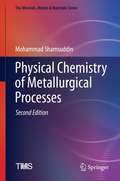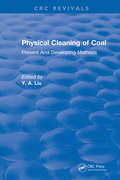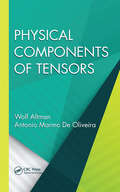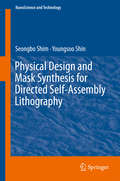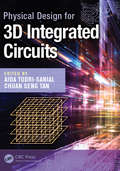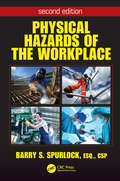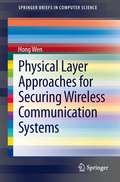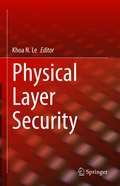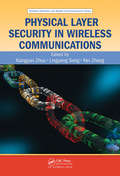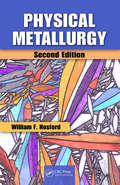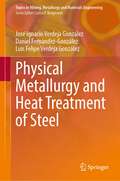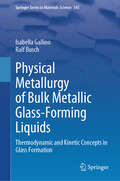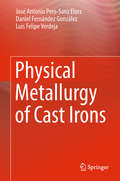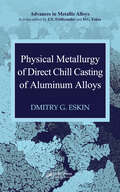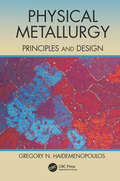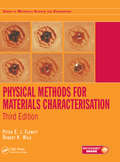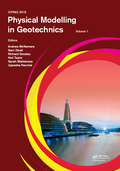- Table View
- List View
Physical Chemistry of Metallurgical Processes, Second Edition (The Minerals, Metals & Materials Series)
by Mohammad ShamsuddinThis updated, second edition retains its classroom-tested treatment of physical chemistry of metallurgical topics, such as roasting of sulfide minerals, matte smelting, converting, structure, properties and theories of slag, reduction of oxides and reduction smelting, interfacial phenomena, steelmaking, secondary steelmaking, role of halides in extraction of metals, refining, hydrometallurgy and electrometallurgy, and adds new data in worked-out examples as well as up-to-date references to the literature. The book further explains the physical chemistry of various metallurgical topics, steps involved in extraction of metals, such as roasting, matte smelting/converting, reduction smelting, steelmaking reactions, deoxidation, stainless steelmaking, vacuum degassing, refining, leaching, chemical precipitation, ion exchange, solvent extraction, cementation, gaseous reduction and electrowinning. Each topic is illustrated with appropriate examples of applications of the technique in extraction of some common, reactive, rare, or refractory metal together with worked out problems explaining the principle of the operation. The problems require imagination and critical analyses and also encourage readers for creative application of thermodynamic data in metal extraction.Updates and condenses text throughout the book by sequential arrangement of paragraphs in different chapters;Maximizes readers’ understanding of the physicochemical principles involved in extraction/production of common and rare/reactive metals by pyro- as well as hydrometallurgical routes;Reinforces concepts presented with worked examples in each chapter explaining the process steps;Explains the physical chemistry of various metallurgical steps, such as roasting, matte smelting/converting, and reduction smelting, steelmaking, aqueous processing etc. in extraction of metals;Collects and uniformly presents scattered information on physicochemical principles of metal production from various books and journals.
Physical Chemistry: Thermodynamics
by Horia MetiuThis is a new undergraduate textbook on physical chemistry by Horia Metiu published as four separate paperback volumes. These four volumes on physical chemistry combine a clear and thorough presentation of the theoretical and mathematical aspects of the subject with examples and applications drawn from current industrial and academic research. By using the computer to solve problems that include actual experimental data, the author is able to cover the subject matter at a practical level. The books closely integrate the theoretical chemistry being taught with industrial and laboratory practice. This approach enables the student to compare theoretical projections with experimental results, thereby providing a realistic grounding for future practicing chemists and engineers. Each volume of Physical Chemistry includes Mathematica® and Mathcad® Workbooks on downloadable resources.Metiu's four separate volumes-Thermodynamics, Statistical Mechanics, Kinetics, and Quantum Mechanics-offer built-in flexibility by allowing the subject to be covered in any order.These textbooks can be used to teach physical chemistry without a computer, but the experience is enriched substantially for those students who do learn how to read and write Mathematica® or Mathcad® programs. A TI-89 scientific calculator can be used to solve most of the exercises and problems.® Mathematica is a registered trademark of Wolfram Research, Inc.® Mathcad is a registered trademark of Mathsoft Engineering & Education, Inc.
Physical Cleaning of Coal: Present Developing Methods
by Y. A. LiuThis book provides a detailed account of recent developments in physical coal cleaning methods including: Relative density, Electrical conductivity, Magnetic susceptibility surface chemistry characteristics.
Physical Components of Tensors (Applied and Computational Mechanics)
by Wolf Altman Antonio Marmo OliveiraIllustrating the important aspects of tensor calculus, and highlighting its most practical features, Physical Components of Tensors presents an authoritative and complete explanation of tensor calculus that is based on transformations of bases of vector spaces rather than on transformations of coordinates. Written with graduate students, professors, and researchers in the areas of elasticity and shell theories in mind, this text focuses on the physical and nonholonomic components of tensors and applies them to the theories. It establishes a theory of physical and anholonomic components of tensors and applies the theory of dimensional analysis to tensors and (anholonomic) connections. This theory shows the relationship and compatibility among several existing definitions of physical components of tensors when referred to nonorthogonal coordinates. The book assumes a basic knowledge of linear algebra and elementary calculus, but revisits these subjects and introduces the mathematical backgrounds for the theory in the first three chapters. In addition, all field equations are also given in physical components as well.Comprised of five chapters, this noteworthy text: Deals with the basic concepts of linear algebra, introducing the vector spaces and the further structures imposed on them by the notions of inner products, norms, and metrics Focuses on the main algebraic operations for vectors and tensors and also on the notions of duality, tensor products, and component representation of tensors Presents the classical tensor calculus that functions as the advanced prerequisite for the development of subsequent chapters Provides the theory of physical and anholonomic components of tensors by associating them to the spaces of linear transformations and of tensor products and advances two applications of this theory Physical Components of Tensors contains a comprehensive account of tensor calculus, and is an essential reference for graduate students or engineers concerned with solid and structural mechanics.
Physical Design and Mask Synthesis for Directed Self-Assembly Lithography (NanoScience and Technology)
by Youngsoo Shin Seongbo ShimThis book discusses physical design and mask synthesis of directed self-assembly lithography (DSAL). It covers the basic background of DSAL technology, physical design optimizations such as placement and redundant via insertion, and DSAL mask synthesis as well as its verification. Directed self-assembly lithography (DSAL) is a highly promising patterning solution in sub-7nm technology.
Physical Design for 3D Integrated Circuits (Devices, Circuits, and Systems #Vol. 55)
by Chuan Seng Tan Aida Todri-SanialPhysical Design for 3D Integrated Circuits reveals how to effectively and optimally design 3D integrated circuits (ICs). It also analyzes the design tools for 3D circuits while exploiting the benefits of 3D technology. <P><P>The book begins by offering an overview of physical design challenges with respect to conventional 2D circuits, and then each chapter delivers an in-depth look at a specific physical design topic. This comprehensive reference: <li>Contains extensive coverage of the physical design of 2.5D/3D ICs and monolithic 3D ICs <li>Supplies state-of-the-art solutions for challenges unique to 3D circuit design <li>Features contributions from renowned experts in their respective fields <P><P>Physical Design for 3D Integrated Circuits provides a single, convenient source of cutting-edge information for those pursuing 2.5D/3D technology.
Physical Fundamentals of Oscillations: Frequency Analysis Of Periodic Motion Stability
by Leonid Chechurin Sergej ChechurinThe book introduces possibly the most compact, simple and physically understandable tool that can describe, explain, predict and design the widest set of phenomena in time-variant and nonlinear oscillations. The phenomena described include parametric resonances, combined resonances, instability of forced oscillations, synchronization, distributed parameter oscillation and flatter, parametric oscillation control, robustness of oscillations and many others. Although the realm of nonlinear oscillations is enormous, the book relies on the concept of minimum knowledge for maximum understanding. This unique tool is the method of stationarization, or one frequency approximation of parametric resonance problem analysis in linear time-variant dynamic systems. The book shows how this can explain periodic motion stability in stationary nonlinear dynamic systems, and reveals the link between the harmonic stationarization coefficients and describing functions. As such, the book speaks the language of control: transfer functions, frequency response, Nyquist plot, stability margins, etc. An understanding of the physics of stability loss is the basis for the design of new oscillation control methods for, several of which are presented in the book. These and all the other findings are illustrated by numerical examples, which can be easily reproduced by readers equipped with a basic simulation package like MATLAB with Simulink. The book offers a simple tool for all those travelling through the world of oscillations, helping them discover its hidden beauty. Researchers can use the method to uncover unknown aspects, and as a reference to compare it with other, for example, abstract mathematical means. Further, it provides engineers with a minimalistic but powerful instrument based on physically measurable variables to analyze and design oscillatory systems.
Physical Hazards of the Workplace (Occupational Safety & Health Guide Series)
by Barry SpurlockThe recognition and control of hazards in the work environment are the cornerstone of every company’s safety and health plan. Every workplace contains dangers, especially those devoted to technology, machinery, and potentially hazardous material. This book provides you with the information you need to understand the regulations that provide for facility safety and their successful implementation for profitable management of any business. <P><P>FEATURES <li>Explores both occupational and environmental hazards <li>Describes the workplace threats from machines, confined spaces, chemicals, personnel, cumulative trauma, environmental issues, electricity, noise, fire and explosion, and the risk of falling <li>Provides measures to protect the eyes, the head, the respiratory system, the circulatory system, and more <li>Details common fire protection countermeasures from an experienced firefighter and fire instructor <li>Addresses ladders, scaffolding and OSHA fall protection standards <li>Includes sections on PPE, laser safety, and forklifts
Physical Layer Approaches for Securing Wireless Communication Systems
by Hong WenThis book surveys the outstanding work of physical-layer (PHY) security, including the recent achievements of confidentiality and authentication for wireless communication systems by channel identification. A practical approach to building unconditional confidentiality for Wireless Communication security by feedback and error correcting code is introduced and a framework of PHY security based on space time block code (STBC) MIMO system is demonstrated. Also discussed is a scheme which combines cryptographic techniques implemented in the higher layer with the physical layer security approach using redundant antennas of MIMO systems to provide stronger security for wireless networks. The channel responses between communication peers have been explored as a form of fingerprint with spatial and temporal uniqueness. Finally, the book develops a new lightweight method of channel identification for Sybil attack and node clone detection in wireless sensor networks (WSNs).
Physical Layer Multi-Core Prototyping
by Slaheddine Aridhi Jean-François Nezan Maxime Pelcat Jonathan PiatBase stations developed according to the 3GPP Long Term Evolution (LTE) standard require unprecedented processing power. 3GPP LTE enables data rates beyond hundreds of Mbits/s by using advanced technologies, necessitating a highly complex LTE physical layer. The operating power of base stations is a significant cost for operators, and is currently optimized using state-of-the-art hardware solutions, such as heterogeneous distributed systems. The traditional system design method of porting algorithms to heterogeneous distributed systems based on test-and-refine methods is a manual, thus time-expensive, task. Physical Layer Multi-Core Prototyping: A Dataflow-Based Approach provides a clear introduction to the 3GPP LTE physical layer and to dataflow-based prototyping and programming. The difficulties in the process of 3GPP LTE physical layer porting are outlined, with particular focus on automatic partitioning and scheduling, load balancing and computation latency reduction, specifically in systems based on heterogeneous multi-core Digital Signal Processors. Multi-core prototyping methods based on algorithm dataflow modeling and architecture system-level modeling are assessed with the goal of automating and optimizing algorithm porting. With its analysis of physical layer processing and proposals of parallel programming methods, which include automatic partitioning and scheduling, Physical Layer Multi-Core Prototyping: A Dataflow-Based Approach is a key resource for researchers and students. This study of LTE algorithms which require dynamic or static assignment and dynamic or static scheduling, allows readers to reassess and expand their knowledge of this vital component of LTE base station design.
Physical Layer Security
by Khoa N. LeThis book studies the vulnerability of wireless communications under line-of-sight (LoS) and non-LoS correlated fading environments. The authors theoretically and practically provide physical layer security analyses for several technologies and networks such as Fifth-Generation (5G) networks, Internet of Things (IoT) applications, and Non-orthogonal multiple access (NOMA). The authors have provided these under various practical scenarios, and developed theoretical aspects to validate their proposed applications. Presents physical layer security (PLS) under correlated fading environments, 5G wireless networks, and NOMA networks;Provides end-to-end analyses, combination of channel correlation and outdated CSI and their effects on PL;Includes contributions of PLS research written by global experts in academia and industry.
Physical Layer Security in Power Line Communications: Fundamentals, Models and Applications (Advances in Information Security #108)
by Roberto Di Pietro Javier Hernandez Fernandez Aymen OmriThis book emerges as a seminal work, addressing the critical need for robust security for power line communications (PLC), during an era where digital interconnectivity is paramount yet vulnerable. This comprehensive volume offers a deep dive into the realm of PLC, a technology increasingly central to our interconnected power grid infrastructure and explores its potential as a cornerstone for various applications. This book opens with a clear and informative introduction to PLC, shedding light on its present status and importance. The authors then delve into the heart of the matter: the application of physical layer security (PLS) in PLC networks. PLS, an emerging field in its own right, is presented as a vital complement or alternative to traditional communications security methods, especially relevant for securing networks of low-complexity devices that are pivotal in PLC applications. This exhaustive treatment of PLS in PLC is unprecedented, both in its scope and depth. This book not only clarifies the fundamental principles of PLS in PLC, but also provides actionable insights for mitigating risks and enhancing resilience. Targeted towards engineers, researchers, graduate students and practitioners grappling with the multifaceted aspects of cybersecurity in energy infrastructure, this book stands out for its clarity, rigor, and the practical applicability of its content. The authors share the results of their extensive research journey and practice, presenting compelling use cases that underscore the practicality of their findings, as well as insights to be prepared for the next challenges in the security of the grid infrastructure.
Physical Layer Security in Wireless Communications (Wireless Networks and Mobile Communications #20)
by Lingyang Song Yan Zhang Xiangyun ZhouPhysical layer security has recently become an emerging technique to complement and significantly improve the communication security of wireless networks. Compared to cryptographic approaches, physical layer security is a fundamentally different paradigm where secrecy is achieved by exploiting the physical layer properties of the communication syst
Physical Metallurgy
by Peter HaasenThis is the fourth edition of a work which first appeared in 1965. The first edition had approximately one thousand pages in a single volume. This latest volume has almost three thousand pages in 3 volumes which is a fair measure of the pace at which the discipline of physical metallurgy has grown in the intervening 30 years. Almost all the topics previously treated are still in evidence in this version which is approximately 50% bigger than the previous edition. All the chapters have been either totally rewritten by new authors or thoroughly revised and expanded, either by the third-edition authors alone or jointly with new co-authors. Three chapters on new topics have been added, dealing with dry corrosion, oxidation and protection of metal surfaces; the dislocation theory of the mechanical behavior of intermetallic compounds; and (most novel) a chapter on polymer science for metallurgists, which analyses the conceptual mismatch between metallurgists' and polymer scientists' way of looking at materials. Special care has been taken throughout all chapters to incorporate the latest experimental research results and theoretical insights. Several thousand citations to the research and review literature are included in this edition. There is a very detailed subject index, as well as a comprehensive author index. The original version of this book has long been regarded as the standard text in physical metallurgy and this thoroughly rewritten and updated version will retain this status.
Physical Metallurgy
by William F. HosfordFor students ready to advance in their study of metals, Physical Metallurgy, Second Edition uses engaging historical and contemporary examples that relate to the applications of concepts in each chapter.This book combines theoretical concepts, real alloy systems, processing procedures, and examples of real-world applications. The author uses his ex
Physical Metallurgy and Heat Treatment of Steel (Topics in Mining, Metallurgy and Materials Engineering)
by José Ignacio Verdeja González Luis Felipe Verdeja González Daniel Fernández-GonzálezThis book covers the physical metallurgy of steels as well as the heat treatments used to improve the their properties. A full chapter is dedicated to the atmospheres in the steelmaking, including the implications of the own gases generated in the iron and steelmaking factories and how they could be applied in these treatments. This book is specially conceived for graduate and undergraduate courses, being the result of more than 30 years of teaching experience in courses for undergraduate, graduate (master and Ph. D.), and companies (technicians). The trends in the re-utilization of industrial gases in the iron and steelmaking process are discussed by the authors. Additionally, the book comprises 41 solved exercises, problems and case-studies, as a complement of the theoretical sections of the text. These exercises, problems, and case-studies are based on problems observed in the industrial practice.
Physical Metallurgy of Bulk Metallic Glass-Forming Liquids: Thermodynamic and Kinetic Concepts in Glass Formation (Springer Series in Materials Science #341)
by Isabella Gallino Ralf BuschThis book deepens the current understanding of the thermodynamics and kinetics of metallic glass-forming liquids, and their connection with the glass-formation process in terms of fundamental physical metallurgy concepts. It surveys and reports on the progress made in the last few decades to access the ultra-viscous liquid state of thermally stable bulk metallic glass (BMG) forming alloys and study the changes in atomic structure, viscosity, and enthalpy during the vitrification including physical aging.Featuring a comprehensive look at the physical properties of the undercooled liquid in the ultra-viscous state at temperatures near the glass transition, the book reports on detailed investigations of the thermodynamic functions, viscosity, volume, relaxation time, and structural ordering in the undercooled liquid. Additionally, it introduces state-of-the-art in-situ characterization tools such as chip-calorimetry, synchrotron x-ray diffraction, and x-ray photon correlation spectroscopy as applied to novel studies of liquid–liquid transitions in the supercooled liquid and in the vicinity of the glass transition, and establishes these common, if not universal, phenomena in BMG-forming alloys.This book is intended for researchers, graduate students, and professionals in the fields of materials science, physical metallurgy, and condensed matter physics, who are interested in the thermodynamics and kinetics of metallic glass-forming liquids and their connection with the glass formation process.
Physical Metallurgy of Cast Irons
by José Antonio Pero-Sanz Elorz Daniel Fernández González Luis Felipe VerdejaThis textbook focuses on cast irons, the second material in production and consumption after steel. The authors describe the Fe-C stable and metastable diagrams from the physical-chemical metallurgy point of view. The main properties of cast irons are presented and justified for all kinds of cast irons: low cost, excellent castability, mechanical properties depending on the graphite morphology (gray irons) and high wear resistance (white irons). The physical metallurgy of highly alloyed cast irons is also described, particularly that one of those used as a consequence of their abrasion, corrosion and heat resistance. The book presents exercises, problems and cases studies, with different sections dedicated to the molding practice. The book finishes with the production cast irons in the cupola furnace. This concise textbook is particularly of interest for students and engineers that work in industries related to cast irons.
Physical Metallurgy of Direct Chill Casting of Aluminum Alloys (Advances in Metallic Alloys)
by Dmitry G. EskinPulling together information previously scattered throughout numerous research articles into one detailed resource, this book connects the fundamentals of structure formation during solidification with the practically observed structure and defect patterns in billets and ingots. The author examines the formation of a structure, properties, and defects in the as-cast material in tight correlation to the physical phenomena involved in the solidification and the process parameters. Compiling recent results and data, the book discusses the fundamentals of solidification together with metallurgical and technological aspects of DC casting. It gives new insight and perspective into DC casting research.
Physical Metallurgy: Principles and Design
by Gregory N. HaidemenopoulosPhysical metallurgy is one of the main fields of metallurgical science dealing with the development of the microstructure of metals in order to achieve desirable properties required in technological applications. Physical Metallurgy: Principles and Design focuses on the processing–structure–properties triangle as it applies to metals and alloys. It introduces the fundamental principles of physical metallurgy and the design methodologies for alloys and processing. The first part of the book discusses the structure and change of structure through phase transformations. The latter part of the books deals with plastic deformation, strengthening mechanisms, and mechanical properties as they relate to structure. The book also includes a chapter on physical metallurgy of steels and concludes by discussing the computational tools, involving computational thermodynamics and kinetics, to perform alloy and process design.
Physical Methods for Materials Characterisation (Series in Materials Science and Engineering)
by Peter E. Flewitt Robert K. WildThis completely revised and expanded new edition covers the full range of techniques now available for the investigation of materials structure and accurate quantitative determination of microstructural features within materials. It continues to provide the best introductory resource for understanding the interrelationship between microstructure and physical, mechanical, and chemical properties, as well as selection and application of techniques for both basic and applied studies. In particular, changes have been made to reflect developments in analysis of nanoscale and biological materials.
Physical Modeling and Computational Techniques for Thermal and Fluid-dynamics: Practical Numerical Mathematics (Mechanical Engineering Series)
by Maurizio BottoniThis book on computational techniques for thermal and fluid-dynamic problems arose from seminars given by the author at the Institute of Nuclear Energy Technology of Tsinghua University in Beijing, China. The book is composed of eight chapters-- some of which are characterized by a scholastic approach, others are devoted to numerical solution of ordinary differential equations of first order, and of partial differential equations of first and second order, respectively. In Chapter IV, basic concepts of consistency, stability and convergence of discretization algorithms are covered in some detail. Other parts of the book follow a less conventional approach, mainly informed by the author’s experience in teaching and development of computer programs. Among these is Chapter III, where the residual method of Orthogonal Collocations is presented in several variants, ranging from the classical Galerkin method to Point and Domain Collocations, applied to numerical solution of partial differential equations of first order. In most cases solutions of fluid dynamic problems are led through the discretization process, to the numerical solutions of large linear systems. Intended to impart a basic understanding of numerical techniques that would enable readers to deal with problems of Computational Fluid Dynamics at research level, the book is ideal as a reference for graduate students, researchers, and practitioners.
Physical Modelling in Geotechnics, Volume 1: Proceedings of the 9th International Conference on Physical Modelling in Geotechnics (ICPMG 2018), July 17-20, 2018, London, United Kingdom
by Neil Taylor Andrew McNamara Sam Divall Richard Goodey Sarah Stallebrass Jignasha PanchalPhysical Modelling in Geotechnics collects more than 1500 pages of peer-reviewed papers written by researchers from over 30 countries, and presented at the 9th International Conference on Physical Modelling in Geotechnics 2018 (City, University of London, UK 17-20 July 2018). The ICPMG series has grown such that two volumes of proceedings were required to publish all contributions. The books represent a substantial body of work in four years. Physical Modelling in Geotechnics contains 230 papers, including eight keynote and themed lectures representing the state-of-the-art in physical modelling research in aspects as diverse as fundamental modelling including sensors, imaging, modelling techniques and scaling, onshore and offshore foundations, dams and embankments, retaining walls and deep excavations, ground improvement and environmental engineering, tunnels and geohazards including significant contributions in the area of seismic engineering. ISSMGE TC104 have identified areas for special attention including education in physical modelling and the promotion of physical modelling to industry. With this in mind there is a special themed paper on education, focusing on both undergraduate and postgraduate teaching as well as practicing geotechnical engineers. Physical modelling has entered a new era with the advent of exciting work on real time interfaces between physical and numerical modelling and the growth of facilities and expertise that enable development of so called ‘megafuges’ of 1000gtonne capacity or more; capable of modelling the largest and most complex of geotechnical challenges. Physical Modelling in Geotechnics will be of interest to professionals, engineers and academics interested or involved in geotechnics, geotechnical engineering and related areas. The 9th International Conference on Physical Modelling in Geotechnics was organised by the Multi Scale Geotechnical Engineering Research Centre at City, University of London under the auspices of Technical Committee 104 of the International Society for Soil Mechanics and Geotechnical Engineering (ISSMGE). City, University of London, are pleased to host the prestigious international conference for the first time having initiated and hosted the first regional conference, Eurofuge, ten years ago in 2008. Quadrennial regional conferences in both Europe and Asia are now well established events giving doctoral researchers, in particular, the opportunity to attend an international conference in this rapidly evolving specialist area. This is volume 1 of a 2-volume set.
Physical Modelling in Geotechnics, Volume 2: Proceedings of the 9th International Conference on Physical Modelling in Geotechnics (ICPMG 2018), July 17-20, 2018, London, United Kingdom
by Neil Taylor Andrew McNamara Sam Divall Richard Goodey Sarah Stallebrass Jignasha PanchalPhysical Modelling in Geotechnics collects more than 1500 pages of peer-reviewed papers written by researchers from over 30 countries, and presented at the 9th International Conference on Physical Modelling in Geotechnics 2018 (City, University of London, UK 17-20 July 2018). The ICPMG series has grown such that two volumes of proceedings were required to publish all contributions. The books represent a substantial body of work in four years. Physical Modelling in Geotechnics contains 230 papers, including eight keynote and themed lectures representing the state-of-the-art in physical modelling research in aspects as diverse as fundamental modelling including sensors, imaging, modelling techniques and scaling, onshore and offshore foundations, dams and embankments, retaining walls and deep excavations, ground improvement and environmental engineering, tunnels and geohazards including significant contributions in the area of seismic engineering. ISSMGE TC104 have identified areas for special attention including education in physical modelling and the promotion of physical modelling to industry. With this in mind there is a special themed paper on education, focusing on both undergraduate and postgraduate teaching as well as practicing geotechnical engineers. Physical modelling has entered a new era with the advent of exciting work on real time interfaces between physical and numerical modelling and the growth of facilities and expertise that enable development of so called ‘megafuges’ of 1000gtonne capacity or more; capable of modelling the largest and most complex of geotechnical challenges. Physical Modelling in Geotechnics will be of interest to professionals, engineers and academics interested or involved in geotechnics, geotechnical engineering and related areas. The 9th International Conference on Physical Modelling in Geotechnics was organised by the Multi Scale Geotechnical Engineering Research Centre at City, University of London under the auspices of Technical Committee 104 of the International Society for Soil Mechanics and Geotechnical Engineering (ISSMGE). City, University of London, are pleased to host the prestigious international conference for the first time having initiated and hosted the first regional conference, Eurofuge, ten years ago in 2008. Quadrennial regional conferences in both Europe and Asia are now well established events giving doctoral researchers, in particular, the opportunity to attend an international conference in this rapidly evolving specialist area. This is volume 2 of a 2-volume set.
Physical Modelling in Geotechnics: Proceedings of the International Conference ICPGM '02, St John's, Newfoundland, Canada. 10-12 July 2002
by R. Popescu R. Phillips P. GuoPapers cover topics including: physical modelling facilities; experimental advances; seismic experimental advances; education; soil behaviour; offshore systems; cold regions; geo-environment; dynamics; earthquake effects; and strategies for disaster reduction.
